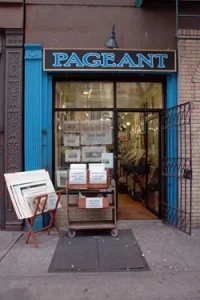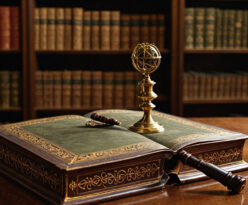Book Row was the legendary six-block stretch of Fourth Avenue between Union Square and Astor Place that once held the densest concentration of used and antiquarian bookstores in America. From the 1890s through the 1960s, it served as a magnet for readers, scholars, collectors, and dreamers. The street became known as “the book lovers’ mile,” a pilgrimage route for anyone who loved the printed word.
Origins and Formation (1890s–1920s)
The district emerged naturally from New York’s late-nineteenth-century publishing hub. Cheap rents, sturdy brick buildings, and proximity to Cooper Union made Fourth Avenue ideal for storing thousands of books. Early dealers sold publisher remainders and estate libraries, displaying boxes and carts outside to lure passers-by. By the early 1900s, the synergy of clustered bookshops created an entire micro-economy of book trading and browsing.
The Golden Age (1930s–1950s)

At its height, Book Row contained forty to fifty shops stacked floor to ceiling, selling everything from ten-cent paperbacks to Shakespeare folios. Bargain tables lined the sidewalks, and narrow aisles inside overflowed with precarious piles of books. Proprietors were scholars, eccentrics, and raconteurs—people like Ben Bass of the Strand, Louis Cohen of the Argosy, and Samuel Weiser, who built a following among mystics and occultists. Their stores formed a living network of discovery and expertise, where one could spend entire days wandering from shelf to shelf.
Cultural Significance
Book Row was not merely commerce; it was community. Writers and editors frequented its shops, professors built reading lists there, and collectors honed their eye for rarity. It was New York’s answer to London’s Charing Cross Road—a democratic temple of print where the boundaries between high literature and the bargain bin disappeared. The dealers’ camaraderie and rivalry alike shaped American bookselling for decades to come.
Decline and Dispersal (1950s–1970s)
After World War II, redevelopment and rising rents began to squeeze the trade. The economics of used-book retail—dependent on large space and small margins—could not compete with office and apartment conversions. One by one, shops closed or moved uptown. The Strand relocated to Broadway and 12th Street in 1957; the Argosy found new life on East 59th Street. By the late 1960s, only a handful remained. A 1969 New York Times article mourned the loss of Book Row’s atmosphere; by 1984, the row had effectively vanished.
Legacy

Though the storefronts are gone, Book Row’s spirit endures. The Strand stands as its direct descendant, and the Argosy continues as one of the country’s great antiquarian firms. Collectors still evoke the magic of Fourth Avenue—its dust, its dim light, and the thrill of serendipitous discovery. The legacy of Book Row lives on wherever books are handled with curiosity and reverence.
Key Bookstores of New York’s Book Row
| Bookstore | Founded | Original Address | Specialty / Character | Fate |
|---|---|---|---|---|
| The Strand Bookstore | 1927 – Ben Bass | 828 Broadway (originally on Fourth Avenue) | Used & new books, modern firsts | Survives on Broadway & 12th St.; still family-run |
| Argosy Book Store | 1925 – Louis Cohen | Bible House, Fourth Ave & 9th St. | Antiquarian books, prints, maps | Moved to E. 59th St.; thriving today |
| Schulte’s Book Store | ca. 1920 – George Schulte | 79 Fourth Ave. | Remainders & general used stock | Closed 1950s |
| Biblo & Tannen | 1940s – Tannen family | 63 Fourth Ave. | Scholarly & academic texts | Moved uptown; closed 1970s |
| Samuel Weiser’s Bookshop | 1926 – Samuel Weiser | 845 Broadway | Occult, mystical & metaphysical works | Moved to Greenwich Village; closed 1990s |
| Pageant Book & Print Shop | 1946 – Sidney Bowers & Henry Stein | 65 Fourth Ave. (later 109 E. 9th St.) | Illustrated books, art prints, modern literature | Moved to E. 4th St.; closed 1999; revived in East Village in 2000s |
| David K. Trinder Book Shop | 1930s | 77 Fourth Ave. | Americana, travel, modern firsts | Closed by 1970 |
| Dauber & Pine | 1910s | 59 Fourth Ave. | Judaica & theology | Moved uptown; later closed |
| The Corner Book Shop | early 1900s | 4th Ave & 10th St. | General used books | Closed mid-century |
| University Place Book Shop | 1940s | 821 Broadway | Scholarly texts & university books | Closed 1970s |
Pageant Book & Print Shop

Founded in 1946 by Sidney Bowers and Henry Stein, Pageant Book & Print Shop bridged Book Row’s past and future. It specialized in illustrated books, fine printing, modern literature, and art prints. When rising rents forced its departure from Fourth Avenue, it moved to 69 East 4th Street and continued until 1999. A revival in the East Village in the early 2000s kept the Pageant name alive. Its blend of bibliophilia and art culture embodied Book Row’s enduring spirit.
Epilogue
Book Row’s story is a parable of urban change and literary culture. What began as a cluster of book peddlers became an intellectual landmark. Its disappearance marked the end of an era, but its influence still echoes in every bookshop, fair, and collector’s shelf where New York’s love for books lives on.
Content retrieved from: https://www.6sqft.com/a-history-of-book-row-nycs-long-time-downtown-haven-for-bibliophiles/
